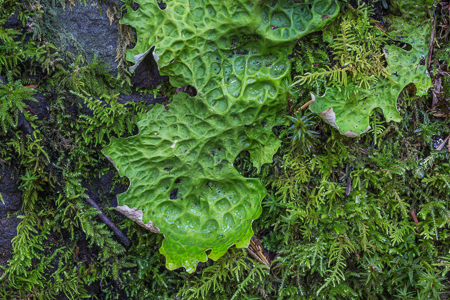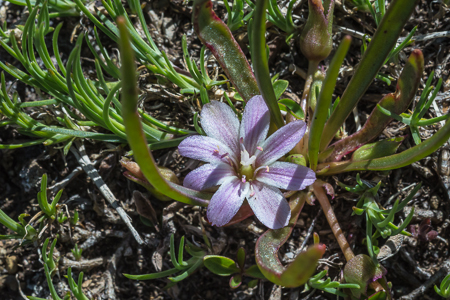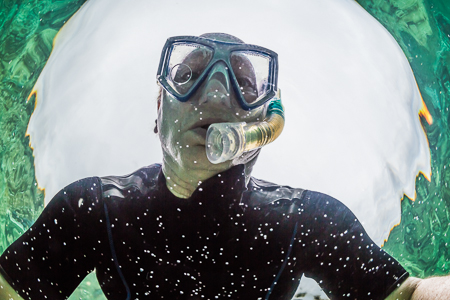 Our tent on a ridge, with Warrior Peak and Mount Constance and the incredible starry sky in the distance
Our tent on a ridge, with Warrior Peak and Mount Constance and the incredible starry sky in the distance
3,800′ of vertical gain. Yes, 3,800′. With a full backpack, in about 5.8 miles. It was an exhausting climb–especially the last 300 vertical feet, which had the steepest pitch. But we did it!
Yes, we knew Marmot Pass was a difficult hike, since we had done it once–23 years ago. We had vowed not to do it again, because we remembered the difficult hike, and the rainy night at Camp Misery, about 4.5 miles in. Oh, did I say Camp Misery? I meant Camp Mystery, as in: it’s mysterious why anyone would want to camp there, in a tangle of dark trees that still sport the stink of decades-ago campfires.
 Picking Wild Strawberries at the trailhead
Picking Wild Strawberries at the trailhead
We arrived at the trailhead at about 10:00 a.m. on a Saturday morning, thankful for the spider web of logging roads that gets hikers closer to the pass than would have been the case decades ago. We pulled on our hiking boots, adjusted our packs, hung the trailhead pass from the rear-view mirror, then walked over to the bulletin board to sign in, where we read the standard warnings about fire and cougars and bears. Oh my.
 The Big Quilcene River cascades quickly from the Olympic Mountains
The Big Quilcene River cascades quickly from the Olympic Mountains
There were four of us on the trip, with three of us training for the steep ascent into The Enchantments in about three weeks. We started up the trail, light in heart if not in load. My pack and camera gear weighed 45 lbs., which is about 12 lbs. lighter than I will carry in The Enchantments. (Note to myself: remember to pack the Ibuprofen for that trip.)
For the first several miles, the trail parallels the raging and beautiful Big Quilcene River as it tumbles down toward Puget Sound from the steep eastern slope of the Olympics. This area is a real tangle of fallen trees, but the WTA (Washington Trails Association) volunteers recently did a great job on this section of the trail, cutting huge trees that had fallen across the trail and improving drainage with some innovative techniques.
We steadily hiked upward, accompanied by the incredibly complex song of the Pacific Wren, the incredibly off-key song of the Varied Thrush, and the incredibly haunting song of the Hermit Thrush–which may be the most beautiful birdsong I have ever heard. I stopped at a few points to photograph lichens and mosses, which are the intricate little wonders of the lush Olympic Peninsula forest that grow around the bases of immense Western Hemlocks and Douglas Firs.
 Lungwort lichen, one part of the lungs of this moist forest
Lungwort lichen, one part of the lungs of this moist forest
We stopped for lunch near Shelter Rock, about 2.5 miles in, where there were perhaps a dozen tents set up by a boy scout troop. Karen and I ate Dubliner Cheese, brown rice Triscuits, fresh sugar snap peas, and a handful of mixed nuts and dried Michigan cherries. All good energy foods.
We needed the energy for an even steeper and unrelenting grade that people have called Poop Out Drag. The effort was balanced by the mountain meadows here, which sweep steeply up to the crags of Buckhorn and Iron Mountains. These meadows were filled with thousands upon thousands of blossoms of brilliant reddish-orange Indian paintbrushes and bright indigo larkspurs, as well as scores of other species. Spectacular!
 Larkspur and Indian Paintbrush wildflowers fill the lovely meadows
Larkspur and Indian Paintbrush wildflowers fill the lovely meadows
We reached Camp Misery, pausing only to pump water, since water availability above this point is iffy and depends upon snowmelt. Camp Mystery wasn’t as bad as I remembered, but this was a sunny day and I’ve been taking my meds. Several small groups were setting up camp along the trail, and others passed by on the way to higher campsites. This proved to be a busy weekend on the trail: we estimated that we saw several hundred people making the climb to Marmot Pass. With the Dosewallips trails access limited because of a landslide about a decade ago, hiking is concentrated here more than ever.
We resumed our trek, soon entering more beautiful meadows on the way to Marmot Pass, and passed a pudgy blonde Olympic Marmot–a species found only in The Olympics. Up and up, we finally got to Marmot Pass, and were disappointed to see that we really needed to go higher on the ridgeline. Three of us were almost devoid of energy at that point, but we shifted into what my dear wife calls “creeper gear” to make it to the top. There we were rewarded by one of the most spectacular views in this spectacular state, with rugged mountains all around, except for the look back at the valley we had just come up, with Puget Sound sprawling in front of distant Glacier Peak.
 Trail crawling steeply to a high ridge above Marmot Pass
Trail crawling steeply to a high ridge above Marmot Pass
We set up camp with our three tents in a mountain meadow, with perhaps another ten tents around us in what one hiker passing by disdainfully called “Tent City.” We set up our tents in a pattern that I thought would make a good illuminated tent photograph after dark (I was, of course, playing the part of the always-irritating photo director!). Then we heated dinner on our camp stoves, rationing the hot drinks a bit because we didn’t have unlimited water at this location.
 Snowfields lingering on the slopes of Warrior Peak
Snowfields lingering on the slopes of Warrior Peak
 Tree shadows crossing the snowfields below Warrior Peak
Tree shadows crossing the snowfields below Warrior Peak
 Mount Constance catching the last rays of the day
Mount Constance catching the last rays of the day
 One of our group contemplating the dramatic view across the valley of the Upper Dungeness River
One of our group contemplating the dramatic view across the valley of the Upper Dungeness River
 Unidentified distant mountains in the rugged Olympics
Unidentified distant mountains in the rugged Olympics
 Alpenglow illuminates the sky after sunset
Alpenglow illuminates the sky after sunset
Then we settled into an evening of watching the sun sink below the mountains on the western horizon and feeling the air grow chillier. We got into the tents and found it was harder to get warm than we thought it might be, probably because we had used so much of our energy on the long climb. Shortly after 10:00 p.m., I unzippered the sleeping bag and tent and proceeded to take a long series of tent photographs, directing the occupants on how to better create even illumination on the tent walls. Finally, content, I let everybody drift off to sleep and went to bed myself.
 Our three tents, with Mount Constance to the right in the distance
Our three tents, with Mount Constance to the right in the distance
Karen woke me up at 1:00 a.m. and said she was cold–especially her feet. We cuddled for a long time, and finally I had the idea of giving her my down jacket, which I had been using as a pillow. We slipped her legs into the armholes and finally she got toasty warm. One side effect of the really lightweight new tents, like ours, is that they are largely made of mesh and easily let the breezes in. My estimate is that for every pound of weight that you save in using a lightweight tent, you need two additional pounds of sleeping bag and clothing. There are no free lunches in backpacking equipment.
Nature called later in the night, so I walked outside to talk to her. The Milky Way sprawled across the entire sky in a glorious show that our ancestors observed on every clear night. What a sight!
When my alarm went off at 5:30 a.m. on this slightly frosty morning, I went outside to check on photo conditions. The night wind had ceased, and I was immediately comfortable. I was the first one up in all the camps (so give me a gold star!), and I enjoyed the quiet sunrise. Two Mountain Goats walked through a camp farther along the ridge, then departed to the lower meadows. Perhaps the three dogs in that camp growled at them.
 Two Mountain Goats feeding in a high meadow
Two Mountain Goats feeding in a high meadow
 Looking across the morning mists of Puget Sound to Glacier Peak
Looking across the morning mists of Puget Sound to Glacier Peak
Actually, this was a doggy kind of hike. I would guess that we saw about 25 dogs, mostly very well-behaved, including several in close proximity to our camp. Since this hike is completely within Olympic National Forest, dogs are allowed along the trail. Had it been across the valley in Olympic National Park, there would have been a stern ranger giving a warning or writing a ticket to each of these dog owners, and instructing each to vacate the park immediately.
I didn’t hear any barking during the night; perhaps the dogs were as tired from the hike as the humans. One adjacent camp had two little children; I would guess their ages as four and seven. These kids had hiked up a very long ways and were having a great time in the dramatic campsite with their extended family.
The next morning we enjoyed identifying wildflowers and building a snowman. Yes, Karen, you can blame yours truly for the basic construction that led to a catastrophic snowman collapse. At least my engineering didn’t result in a bridge falling, which is reason number 27 as to why I am a photographer instead of an engineer.
 Indian Paintbrush near our tent
Indian Paintbrush near our tent
 Mountain Wallflower on a high ridge
Mountain Wallflower on a high ridge
 The beautiful magenta Olympic Mountain Paintbrush
The beautiful magenta Olympic Mountain Paintbrush
 Alpine Lewisia: this was the first time I had seen this flower, which was named for Meriwether Lewis
Alpine Lewisia: this was the first time I had seen this flower, which was named for Meriwether Lewis
This was a nearly clear day, with just a very few scattered shreds of clouds. I said we should place bets on when a cloud shadow would briefly darken us, and it didn’t occur until mid-afternoon.
At noon, we shouldered our packs, now slightly lighter with less food and water, and slowly descended to the pass, stopping at several places to identify and photograph wildflowers. Then we went lower and dined with the blond Olympic Marmot we had seen the the same place the day before (though she did not appear to like our company and got up from the table and left–I’ve got to stop telling blond jokes around the PC crowd).
 Pretty blond Olympic Marmot below its namesake pass
Pretty blond Olympic Marmot below its namesake pass
 Weathered wood on an ancient tree at timberline
Weathered wood on an ancient tree at timberline
 The beautiful meadows below Marmot Pass, with one tent among the krummholz
The beautiful meadows below Marmot Pass, with one tent among the krummholz
The rest of the hike out was fast and uneventful, and we reached the trailhead at 4:45 p.m. The destination had proven to live up to its reputation as one of the premier hikes in The Olympics, and made me glad that we live in the one place that hosts The Olympics every year.
 Definitely not rolling stones; photographed in the Big Quilcene River near Camp Mystery
Definitely not rolling stones; photographed in the Big Quilcene River near Camp Mystery
For someone thinking about hiking to Marmot Pass, the Olympic National Forest website is a good place to start. Go to Marmot Pass Trail.
Go to LeeRentz.com to view the range of work by Lee Rentz. Work is available as metal or archival paper prints, and most are available for licensing for websites, magazines, and books.






























